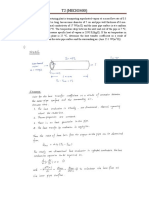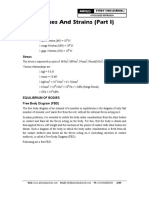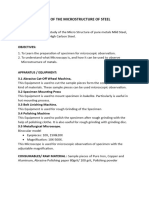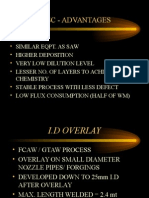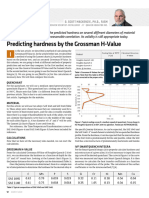03.conduction Part1
03.conduction Part1
Uploaded by
rameshaarya99Copyright:
Available Formats
03.conduction Part1
03.conduction Part1
Uploaded by
rameshaarya99Original Description:
Original Title
Copyright
Available Formats
Share this document
Did you find this document useful?
Is this content inappropriate?
Copyright:
Available Formats
03.conduction Part1
03.conduction Part1
Uploaded by
rameshaarya99Copyright:
Available Formats
One-Dimensional Steady-State Conduction
Conduction problems may involve multiple directions and
time-dependent conditions
Inherently complex Difficult to determine temperature
distributions
One-dimensional steady-state models can represent
accurately numerous engineering systems
In this chapter we will
Learn how to obtain temperature profiles for common geometries with
and without heat generation.
Introduce the concept of thermal resistance and thermal circuits
Chapter 2 : Introduction to Conduction
2
For cartesian coordinates
(2.17)
Chapter 3 : One-dimensional, Steady state conduction
(without thermal generation)
3
3.1 Methodology of a conduction analysis
1. Specify appropriate form of the heat equation
2. Solve for the temperature distribution
3. Apply Fouriers law to determine the heat flux
Simplest case:
- One-dimensional, steady state conduction with no thermal energy
generation
Common geometries:
i. The plane wall: described in rectangular (x)
coordinate. Area perpendicular to direction of heat
transfer is constant (independent of x).
ii. Cylindrical wall : radial conduction through tube
wall
iii. Spherical wall : radial conduction through shell wall
Chapter 3 : One-dimensional, Steady state conduction
(without thermal generation)
4
3.2 The plane wall temperature distribution
assuming steady-state conditions and no
internal heat generation (i.e. q = 0), then
the 1-D heat conduction equation reduces
to:
For constant k and A, second order
differential equation:
.
This mean:
Heat flux (q
x
) is independent of x
Heat rate (q
x
) is independent of x
Boundary conditions: T(0) = T
s,1
T(L) = T
s,2
Using Eq. (2.2) in Chapter 2, by
Chapter 3 : One-dimensional, Steady state conduction
(without thermal generation)
5
1-D heat conduction equation for steady-state
conditions and no internal heat generation (i.e. q
= 0), is
.
for constant k and A
Integrate twice to get T(x)
For boundary conditions: T(0) = T
s,1
and T(L) = T
s,2
at x = 0, T(x) = T
s,1
and C
2
= T
s,1
at x = L, T(x) = T
s,2
and T
s,2
= C
1
L + C
2
= C
1
L + T
s,1
this gives, C
1
= (T
s,2
T
s,1
)/2
and
Using value of C
1
and C
2
, the function of T(x) is
*From here, apply Fouriers
law to get heat transfer, q
x
Chapter 3 : One-dimensional, Steady state conduction
(without thermal generation)
6
Heat rate for plane wall (simplest
case):
Heat flux for plane wall (simplest
case):
Chapter 3 : One-dimensional, Steady state conduction
(without thermal generation)
7
Example: Temp distribution problem
Consider a large plane wall of thickness L = 0.2 m, thermal conductivity k = 1.2
W/mK, and surface area, A = 15m
2
. The two sides of the wall are maintained at
constant temperatures of T
1
= 120C and T
2
= 50C. Determine,
a) The temperature distribution equation within the wall
b) Value of temperature at thickness of 0.1m
c) The rate of heat conduction through the wall under steady conditions
Thermal Resistance
Based on the previous solution, the conduction heat transfer rate can be
calculated:
( )
( )
kA L
T T
T T
L
kA
dx
dT
kA Q
s s
s s x
/
2 , 1 ,
2 , 1 ,
= = =
Recall electric circuit theory - Ohms law for electrical resistance:
Similarly for heat convection, Newtons law of cooling applies:
Resistance
e Differenc Potential
current Electric =
hA
T T
T T hA Q
S
S x
/ 1
) (
) (
= =
And for radiation heat transfer:
A h
T T
T T A h Q
r
sur s
sur s r rad
/ 1
) (
) (
= =
(3.2a)
(3.2b)
(3.2c)
.
.
.
Thermal Resistance
Compare with equations 3.2a-3.2c
The temperature difference is the potential or driving force
for the heat flow and the combinations of thermal
conductivity, convection coefficient, thickness and area of
material act as a resistance to this flow:
We can use this electrical analogy to represent heat transfer problems
using the concept of a thermal circuit (equivalent to an electrical circuit).
A h
R
hA
R
kA
L
R
r
rad t conv t cond t
1
,
1
,
, , ,
= = =
A
= =
R
T
Q
overall
Resistance
Force Driving Overall
.
Chapter 3 : One-dimensional, Steady state conduction
(without thermal generation)
10
3.2.1 Thermal resistances & Thermal circuits
- Interestingly, there exists an analogy between the diffusion of heat and electrical
charge. For example if an electrical resistance is associated with the conduction of
electricity, a thermal resistance may be associated with the conduction of heat.
- Defining thermal resistance for conduction in a plane wall:
- For convection :
- For previous simplest case, thermal circuit for plane wall
with adjoining fluids:
Chapter 3 : One-dimensional, Steady state conduction
(without thermal generation)
11
3.2.1 Thermal resistances & Thermal circuits
- In case of radiation :
where,
Surface temperature
Surrounding temperature
(3.13)
(1.9)
Chapter 3 : One-dimensional, Steady state conduction
(without thermal generation)
12
Example: (Problem 3.2a)
The rear window of an automobile is defogged by passing warm air over its inner
surface. If the warm air is at T
,i
= 40C and the corresponding convection
coefficient is h
i
= 30 W/m
2
K, what are the inner and outer surface temperatures of
4-mm thick window glass, if the outside ambient air temperature is T
,o
= -10C
and the associated convection coefficient is h
o
= 65 W/m
2
K.
Chapter 3 : One-dimensional, Steady state conduction
(without thermal generation)
13
Example (problem 3.5):
The walls of a refrigerator are typically constructed by sandwiching a layer of
insulation between sheet metal panels. Consider a wall made from fibreglass
insulation of thermal conductivity, k
i
= 0.046 W/mK and thickness L
i
= 50 mm
and steel panels, each of thermal conductivity k
p
= 60 W/mK and thickness L
p
= 3
mm. If the wall separates refrigerated air at T
,o
= 25C, what is the heat gain per
unit surface area ?
Coefficients associated with natural convection at the inner and outer surfaces can
be approximated as h
i
= h
o
= 5 W/m
2
K
Chapter 3 : One-dimensional, Steady state conduction
(without thermal generation)
14
3.2.2 The composite wall (with negligible contact resistance)
Chapter 3 : One-dimensional, Steady state conduction
(without thermal generation)
15
Composite wall with negligible contact
resistance:
where,
Overall heat transfer coefficient:
* A modified form of Newtons Law of cooling
to encompass multiple resistances to heat
transfer
The composite wall (series type)
Composite Walls
What is the heat transfer rate for this system?
Alternatively
UA q
T
R R
T UA Q
t tot
x
1
=
A
= =
A =
where U is the overall heat transfer coefficient and AT the overall
temperature difference.
)] / 1 ( ) / ( ) / ( ) / ( ) / 1 [(
1 1
4 1
h k L k L k L h A R
U
C C B B A A tot
+ + + +
= =
.
Chapter 3 : One-dimensional, Steady state conduction
(without thermal generation)
17
The composite wall (parallel type)
Chapter 3 : One-dimensional, Steady state conduction
(without thermal generation)
18
The composite wall (parallel type)
Electric analogy of thermal
circuits
- To solve a parallel resistance
network like that shown opposite,
we can reduce the network to and
equivalent resistance
For electrical circuits:
For thermal circuits:
Chapter 3 : One-dimensional, Steady state conduction
(without thermal generation)
19
Example: parallel resistances
*IR (infrared) photos show that the heat
transfer through the built-up walls is more
complex than predicted by a simple parallel-
resistance.
Chapter 3 : One-dimensional, Steady state conduction
(without thermal generation)
20
Example: (3.15)
Consider a composite wall that includes an 8-mm thick hardwood siding, 40 mm
by 130 mm hardwood studs on 0.65 m centers with glass fibre insulation (paper
faced, 28 kg/m3) and a 12 mm layer of gypsum wall board.
What is the thermal resistance associated with a wall that is 2.5 m high by 6.5 m
wide (having 10 studs, each 2.5 m high)
Chapter 3 : One-dimensional, Steady state conduction
(without thermal generation)
21
Example of resistance network with both radiative and convective
boundary (Example 3.1)
Contact Resistance
Chapter 3 : One-dimensional, Steady state conduction
(without thermal generation)
23
3.3 Contact resistance
It is important to recognise that, in composite systems, the
temperature drop across the interface between material may
be appreciable (present analysis is neglected).
This attributed is due to thermal contact resistance R
t,c
*values depend on:
materials A and B, surface
finishes, interstitial
conditions and contact
pressure
Composite Walls with contact resistances
Chapter 3 : One-dimensional, Steady state conduction
(without thermal generation)
25
Chapter 3 : One-dimensional, Steady state conduction
(without thermal generation)
26
Chapter 3 : One-dimensional, Steady state conduction
(without thermal generation)
27
3.3 Radial systems: cylindrical wall
General heat equation for cylinder (from Chap. 2)
For 1-D steady state, with no heat generation
Integrate twice to get temperature
distribution, T(r). For example, for
constant temperature boundary:
From T(r), heat flux for cylinder
Chapter 3 : One-dimensional, Steady state conduction
(without thermal generation)
28
The thermal resistance for radial conduction
In case of cylinder with composite wall (negligible contact resistance)
Chapter 3 : One-dimensional, Steady state conduction
(without thermal generation)
29
Critical radius for insulation
Adding more insulation to a wall decrease heat transfer
The thicker the insulation, the lower the heat transfer through the wall
However, adding insulation to a cylindrical pipe or a spherical shell is a
different matter.
Additional insulation increase the conduction resistance of the insulation
layer but decrease the convection resistance of the surface because of the
increase in the outer surface area for convection
Hence, knowledge of critical radius of insulation
is required
Chapter 3 : One-dimensional, Steady state conduction
(without thermal generation)
30
Critical radius for insulation: see example 3.5 in Textbook
for details
If r
i
< r
cr
, R
tot
decreases and the heat
rate therefore
increases with
insulation
If r
i
> r
cr
, R
tot
increases
and therefore heat rate
decreases with
insulation
Insulation prop.
Outside conv. coeff.
Chapter 3 : One-dimensional, Steady state conduction
(without thermal generation)
31
Example 3.39: cylinder
A stainless steel (AISI 304) tube used to transport a chilled pharmaceutical has an
inner diameter of 36 mm and a wall thickness of 2 mm. The pharmaceutical and
ambient air are at temperatures of 6C and 23C, respectively, while the
corresponding inner and outer convection coefficients are 400 W/m
2
K and 6
W/m
2
K, respectively.
i) What is the heat gain per unit tube length (W/m) ?
ii) What is the heat gain per unit length if a 10-mm thick layer of calcium silicate
insulation (k
ins
= 0.050 W/mK) is applied to the tube. Discuss the result with
the knowledge of r
crit
.
(12.6 W/m, 7.7 W/m)
Chapter 3 : One-dimensional, Steady state conduction
(without thermal generation)
32
3.4 Radial systems: spherical wall
General heat equation for sphere (from Chap. 2)
For 1-D steady state, with no heat generation
Integrate twice to get temperature distribution for
constant k, T(r)
From T(r), heat flux for sphere
Chapter 3 : One-dimensional, Steady state conduction
(without thermal generation)
33
The thermal resistance for radial conduction in
sphere
In case of sphere with composite shell (negligible contact resistance)
The total thermal resistance due to conduction and convection in sphere
Chapter 3 : One-dimensional, Steady state conduction
(without thermal generation)
34
Summary
Chapter 3 : One-dimensional, Steady state conduction
(without thermal generation)
35
Example 3.54:
A storage tank consists of a cylindrical section that has a length and inner diameter
of L=2m and D
i
=1m, respectively, and two hemispherical end sections. The tank is
constructed from 20 mm thick glass (Pyrex) and is exposed to ambient air for
which the temperature is 300K and the convection coefficient is 10 W/m
2
K. The
tank is used to store heated oil, which maintains the inner surface at a temperature
of 400K. Determine the electrical power that must be supplied to a heater
submerged in the oil if the prescribed conditions are to be maintained. Radiation
effects may be neglected, and the Pyrex may be assumed to have a thermal
conductivity of 1.4 W/mK.
You might also like
- MEC551 Test 1 Solution (Sept2011-Feb2012) StudentDocument4 pagesMEC551 Test 1 Solution (Sept2011-Feb2012) StudentHilmyZulkifliNo ratings yet
- Crystallography ExercisesDocument42 pagesCrystallography ExercisesBeth Cortez0% (1)
- Exercise ProblemsDocument11 pagesExercise ProblemsVijaykumar NagathanNo ratings yet
- Chapter 3 Heat Trasnfer 4001Document45 pagesChapter 3 Heat Trasnfer 4001Maria Camila De la RosaNo ratings yet
- 2 ConductionDocument48 pages2 ConductionIslam Saqr0% (1)
- Steady Heat ConductionDocument81 pagesSteady Heat ConductionIsmail MughalNo ratings yet
- T2 Questions and SolutionsDocument10 pagesT2 Questions and Solutionsleroy_quekNo ratings yet
- Electrochem Practice TestDocument41 pagesElectrochem Practice TestaaaaaNo ratings yet
- Chapter 3: Tensile TestingDocument10 pagesChapter 3: Tensile TestingKhairul MuzafarNo ratings yet
- PDFDocument6 pagesPDFAna Lorraine DalilisNo ratings yet
- Exam Structure: Mechanical Behavior of Materials - Q&ADocument8 pagesExam Structure: Mechanical Behavior of Materials - Q&AHarshanaTharinduNo ratings yet
- Stresses and Strains (Part 1)Document44 pagesStresses and Strains (Part 1)AMIE Study Circle, RoorkeeNo ratings yet
- l4 The Clausius-UpadiDocument8 pagesl4 The Clausius-UpadiMarcos Sánchez MartínezNo ratings yet
- ME3122 - Conduction Notes 2014Document164 pagesME3122 - Conduction Notes 2014Wei QuanNo ratings yet
- Chapter 18 ElectrochemistryDocument49 pagesChapter 18 ElectrochemistryDwivelia AftikaNo ratings yet
- Chapter 6 - Inductance, Capacitance, and Mutual Inductance PDFDocument44 pagesChapter 6 - Inductance, Capacitance, and Mutual Inductance PDFDaniaNo ratings yet
- Unit I:Crystal StructureDocument51 pagesUnit I:Crystal Structuresamurai7_77No ratings yet
- Thermo Coupled Stress Analysis of Exhaust Manifold Assemblage Using ABAQUSDocument6 pagesThermo Coupled Stress Analysis of Exhaust Manifold Assemblage Using ABAQUSInfogain publicationNo ratings yet
- PART4 Tensor CalculusDocument43 pagesPART4 Tensor CalculusAjoy SharmaNo ratings yet
- Magnetic MaterialsDocument18 pagesMagnetic MaterialsAmitKumarNo ratings yet
- Structures of Solids: Engr. Ana Lorraine M. Dalilis, RcheDocument71 pagesStructures of Solids: Engr. Ana Lorraine M. Dalilis, RcheAna Lorraine DalilisNo ratings yet
- Battery Design Module Users GuideDocument720 pagesBattery Design Module Users GuidemarkoNo ratings yet
- Lec04 - Imperfections in SolidsDocument16 pagesLec04 - Imperfections in SolidsIan BecerroNo ratings yet
- Solidification, Phase Diagrams and Phase TransformationDocument35 pagesSolidification, Phase Diagrams and Phase TransformationkrishnasaiNo ratings yet
- Material Tech Questions Solved BitsDocument22 pagesMaterial Tech Questions Solved BitsBalakumarNo ratings yet
- ELECTROMETALLURGYDocument13 pagesELECTROMETALLURGYJoseph KehindeNo ratings yet
- Phase Equilibria and Phase TransformationDocument57 pagesPhase Equilibria and Phase TransformationAzhan Haqimi100% (1)
- 4 Defects in Crystalline MaterialsDocument28 pages4 Defects in Crystalline MaterialsschoolNo ratings yet
- Tensor Voting: Theory and Applications: Gérard Medioni Chi-Keung Tang Mi-Suen LeeDocument10 pagesTensor Voting: Theory and Applications: Gérard Medioni Chi-Keung Tang Mi-Suen LeeM Rameez Ur RehmanNo ratings yet
- Study of The Microstructure of SteelDocument9 pagesStudy of The Microstructure of SteelKusum GoreNo ratings yet
- ME 292 - Metallic Materials SessionalDocument39 pagesME 292 - Metallic Materials SessionalMuhammedNayeemNo ratings yet
- Laplace Table PDFDocument2 pagesLaplace Table PDFSnehith Reddy KathiNo ratings yet
- Assignment 1 With SolutionDocument8 pagesAssignment 1 With SolutionFaryal BatoolNo ratings yet
- Electron Theory of SolidsDocument18 pagesElectron Theory of SolidsJoyita100% (1)
- Surface Chemistry - Comprehensive Notes PDFDocument32 pagesSurface Chemistry - Comprehensive Notes PDFGurpreet JindalNo ratings yet
- Optimization of Lattice Structures For Additive Manufacturing TechnologiesDocument10 pagesOptimization of Lattice Structures For Additive Manufacturing TechnologiesJavier Andres Munoz ChavesNo ratings yet
- R09-Fatigue, Creep and Fracture MechanicsDocument2 pagesR09-Fatigue, Creep and Fracture MechanicsKiran KumarNo ratings yet
- Mats 3 Sol 3Document7 pagesMats 3 Sol 3Devansh GargNo ratings yet
- Ch-27.6 Cast IronDocument45 pagesCh-27.6 Cast IronSmruti Ranjan PattanayakNo ratings yet
- Lecture 7 Application DTA & DSC01Document34 pagesLecture 7 Application DTA & DSC01ZUL KAMARUDDINNo ratings yet
- Electrochemistry of SolidsDocument250 pagesElectrochemistry of Solidsmarcelo.rodriguesNo ratings yet
- Som WordDocument130 pagesSom Wordmadicharla nikhilNo ratings yet
- Chapter 2 Crystal StructureDocument38 pagesChapter 2 Crystal StructureAbo Abdo100% (1)
- Stress Analysis Tensor PracticesDocument3 pagesStress Analysis Tensor PracticesmuhibNo ratings yet
- 2 MarksDocument15 pages2 MarksVignesh Durai100% (3)
- TR200Document3 pagesTR200DeepakNo ratings yet
- 2 Electrochemistry (Electrolytic Cells)Document45 pages2 Electrochemistry (Electrolytic Cells)Gerald Paul SumagpaoNo ratings yet
- Emat Fa1.4 - q1.4 Long QuizDocument6 pagesEmat Fa1.4 - q1.4 Long QuizUC MARE MARITIME SYLLABUS CDRCNo ratings yet
- Composite Lecture 2Document28 pagesComposite Lecture 2Nuelcy LubbockNo ratings yet
- Introduction To TensorFlow in PythonDocument146 pagesIntroduction To TensorFlow in Pythonjcmayac100% (1)
- Chapter 2 SolidificationDocument35 pagesChapter 2 SolidificationAyu ArtiniNo ratings yet
- STP1353 Eb.1415051 1 PDFDocument257 pagesSTP1353 Eb.1415051 1 PDFpaolaNo ratings yet
- Assignment 1 - Chapter 3 AnswerDocument9 pagesAssignment 1 - Chapter 3 AnswerHarryzam MartelNo ratings yet
- Solution Tuto 3Document4 pagesSolution Tuto 3Abood AtiyatNo ratings yet
- Thermal and Fluid Characteristics of Three-Layer Microchannels Heat SinksDocument10 pagesThermal and Fluid Characteristics of Three-Layer Microchannels Heat SinksjournalNo ratings yet
- Physical Chemistry Chapter 4 - ElectrochemistryDocument36 pagesPhysical Chemistry Chapter 4 - Electrochemistryjatropos6810No ratings yet
- Introductory Applications of Partial Differential Equations: With Emphasis on Wave Propagation and DiffusionFrom EverandIntroductory Applications of Partial Differential Equations: With Emphasis on Wave Propagation and DiffusionNo ratings yet
- 03.conduction Part1Document35 pages03.conduction Part1Nana TweneboahNo ratings yet
- One-Dimensional Steady-State ConductionDocument31 pagesOne-Dimensional Steady-State ConductionSajjad KheirandishNo ratings yet
- 8th Biology Telugu OptDocument202 pages8th Biology Telugu Optrameshaarya99No ratings yet
- Notification Calling For Nominations For Appointment As Chairman and Members of Telangana State Electricity Regulatory CommissionDocument2 pagesNotification Calling For Nominations For Appointment As Chairman and Members of Telangana State Electricity Regulatory Commissionrameshaarya99No ratings yet
- Chapter-Iii Subhas Chandra Bose and The Indian National CongressDocument70 pagesChapter-Iii Subhas Chandra Bose and The Indian National CongressPriyanka ChauhanNo ratings yet
- Year Book 2015Document538 pagesYear Book 2015Omkar Sangle100% (1)
- Indian Geography: North Longitudes EastDocument2 pagesIndian Geography: North Longitudes Eastrameshaarya99No ratings yet
- Chap 5.1 Conditions Equations of Equilibrium of A Rigid BodyDocument52 pagesChap 5.1 Conditions Equations of Equilibrium of A Rigid Bodyrameshaarya99No ratings yet
- Principles of Production Engineering: Week 1 Structure of MaterialsDocument26 pagesPrinciples of Production Engineering: Week 1 Structure of Materialsrameshaarya99No ratings yet
- UPSC: Engineering Services Exam 2014 General Ability Test Key (Held On 20.06.2014)Document1 pageUPSC: Engineering Services Exam 2014 General Ability Test Key (Held On 20.06.2014)rameshaarya99No ratings yet
- Call - No Candidate Name S.No Candidate Name Call - No S.NoDocument141 pagesCall - No Candidate Name S.No Candidate Name Call - No S.Norameshaarya99No ratings yet
- Past Exam AnsDocument8 pagesPast Exam Ansrameshaarya99No ratings yet
- A and The Maximum Deflection. EI Is ConstantDocument41 pagesA and The Maximum Deflection. EI Is Constantrameshaarya99No ratings yet
- 499347059chemistry Question Bank (2013-14)Document94 pages499347059chemistry Question Bank (2013-14)rameshaarya99No ratings yet
- Devaraj Kiruthika 201112 PHDDocument227 pagesDevaraj Kiruthika 201112 PHDrameshaarya99No ratings yet
- 4.36 4.37Document2 pages4.36 4.37rameshaarya99No ratings yet
- Sonic Well Logging 53aDocument12 pagesSonic Well Logging 53akingsley peprahNo ratings yet
- Vis Spectrophotometer.Document8 pagesVis Spectrophotometer.Shubham KaseraNo ratings yet
- 2F Floor (S4)Document6 pages2F Floor (S4)Zulkiflee TaugNo ratings yet
- Chemical Equilibrium : DPP 01 (Of Lecture 03) || Arjuna NEET 3.0 2024Document3 pagesChemical Equilibrium : DPP 01 (Of Lecture 03) || Arjuna NEET 3.0 2024i.purush.royNo ratings yet
- General DescriptionDocument1,525 pagesGeneral DescriptionBetaLub Mantenimiento y Servicios Comerciales SpANo ratings yet
- Kirby Catalogue Book 2Document270 pagesKirby Catalogue Book 2Nam Tran HoangNo ratings yet
- 12LS-3C 9 Etapas 1770RPM 50LPS@200MDocument1 page12LS-3C 9 Etapas 1770RPM 50LPS@200Mliberkis jimenezNo ratings yet
- Unit 5 - Design of Tall Vertical Vessels by IIT BhuDocument28 pagesUnit 5 - Design of Tall Vertical Vessels by IIT BhuRohit KumarNo ratings yet
- Physical Organic Chemistry 3Document24 pagesPhysical Organic Chemistry 3SamNo ratings yet
- Welding ProcessesDocument28 pagesWelding ProcessesJitendra UmaraliyaNo ratings yet
- UAE Professional Structural Engineer Test - RequirementsDocument3 pagesUAE Professional Structural Engineer Test - RequirementsMelekeenNo ratings yet
- Tut 1Document3 pagesTut 1Prateek SinwarNo ratings yet
- The Energy Equation and Its Applications: Dr. Khalil Mahmoud ALASTALDocument54 pagesThe Energy Equation and Its Applications: Dr. Khalil Mahmoud ALASTALDamion McdowellNo ratings yet
- Viscoelasticity PDFDocument14 pagesViscoelasticity PDFNani DeskaaNo ratings yet
- Bioreactor Engineering: MODULE - 1-SterilisationDocument24 pagesBioreactor Engineering: MODULE - 1-SterilisationssfoodtechNo ratings yet
- Formulation and Evaluation of Nanoemulsion For Solubility Enhancement of KetoconazoleDocument14 pagesFormulation and Evaluation of Nanoemulsion For Solubility Enhancement of KetoconazoledgdNo ratings yet
- Research Biological Binocular MicroscopeDocument4 pagesResearch Biological Binocular MicroscopeAhmed AbouelwafaNo ratings yet
- TP 77 Pap PDFDocument8 pagesTP 77 Pap PDFJaved MohammedNo ratings yet
- D00000 CAT en A4 V01 - Puretec CatalogDocument48 pagesD00000 CAT en A4 V01 - Puretec CatalogcerberusdodoNo ratings yet
- Tutorial 2 /assignment 2-Fluid Power Control (B Batch) - S6MEDocument2 pagesTutorial 2 /assignment 2-Fluid Power Control (B Batch) - S6MEdagem aragawNo ratings yet
- Sample FinalDocument15 pagesSample FinalGeoff HattNo ratings yet
- Predicting Hardness by The Grossman H-Value HOT SEATDocument3 pagesPredicting Hardness by The Grossman H-Value HOT SEATetxeanaNo ratings yet
- On The Magnetic Field of A Finite SolenoidDocument6 pagesOn The Magnetic Field of A Finite Solenoidra101208No ratings yet
- EEE-475 L4T1 19eee Class-5 RemovedDocument14 pagesEEE-475 L4T1 19eee Class-5 RemovedMD Kamruzzaman Siam SaumNo ratings yet
- Sosnik 2015Document70 pagesSosnik 2015Handoko DestaNo ratings yet
- Met302 ADocument4 pagesMet302 AVenkitaraj K PNo ratings yet
- DFMA Rules For WeldingDocument17 pagesDFMA Rules For WeldingArunNo ratings yet
- Magnetic Effect of Current (Practice Questions)Document7 pagesMagnetic Effect of Current (Practice Questions)Somnath BanerjeeNo ratings yet
- Behncke QWT Kullanım Kılavuzu ENDocument23 pagesBehncke QWT Kullanım Kılavuzu EN8nqm4p3veNo ratings yet
- HW1Document3 pagesHW1peer highwayNo ratings yet






